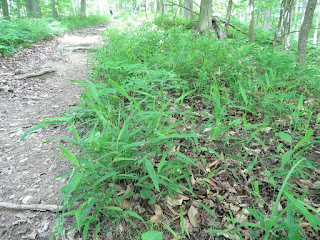Two notable recent disturbances the area has endured, the dying off of large swaths of Bitternut Hickory from the Hickory Bark Beetle and the scars left on the landscape from the 2011 tornado that passed through (check out the blowdown/deadfall disaster on the far bank, and I thought making a pass through a buckthorn thicket was bad!).
Down in the floodplain forests, the groundcover included patches ofCanada Waterleaf (Hydrophyllum canadense).
Twinleaf (Jeffersonia diphylla) was also present throughout the bottomlands. You can see the small seed cup structures poking up through the foliage.
The grass in the front is Black-fruited Mountain Rice (Patis racemosa). This species can be differentiated from White-fruited Mountain Rice (Oryzopsis asperifolia) by it's broader leaves, more robust growth (White-grained leaves are essentially basal with fruiting stems above).
The other Wild Licorice (Galium circaezans), not the old record of (Glycyrrhiza lepidota) I was searching for a couple of weeks back.
A non-native cherry that was new to me Mahaleb Cherry (Prunus mahaleb). The leaves resemble a birch more than the typical native cherry species we tend to come across. Apparently this species is expanding it's range and is becoming more common locally.
Among the Reed Canary Grass banks of the river a few stems of Giant St. Johns-wort (Hypericum ascyron) were spotted. This species is listed as an S3?, so relatively uncommon. I had only seen it once before along the Grand south of Glen Morris.
There was a good assortment of butterflies present yesterday, this Hobomok Skipper stopped briefly for a photo.
Clinton's Wood Fern (Dryopteris clintoniana) which can be distinguished from Marginal Wood Fern (Dryopteris marginalis) by the location/arrangement of the sori on the underside of the leaves (central within the pinnule versus marginal).
Another rarity for the day, Green Dragon (Arisaema dracontium) which is closely related to the common Jack-in-the-Pulpit (Arisaema triphyllum).
This exotic species, Germander Speedwell (Veronica chamaedrys) seemed to be doing quite well both in upland and lowland areas.
Another shot of Slender Satin Grass,
I believe this is Orange Mycena (Mycena leaiana).
Just before lunch we saw a Bald Eagle fly down the river. I've had worse vistas for lunch.
There was definitely alot of sedge ID'ing, I think the day list topped 25 species. If you're on the sedge train then keep reading. Andrew spotted this Smooth-sheath Sedge (Carex laevivaginata). It closely resembles Carex stipata which has shorter perigynia and thin, wrinkled leaf sheaths (versus smooth).
Drooping Sedge (Carex prasina) was found growing along a stream in the bottom of a ravine. This sedge is in the same section as C. gracillima, C. arctata, C. formosa, all of which seem to have fairly stark differences which lend themselves to a quick ID.
For comparison, Handsome Sedge (Carex formosa) was also present, largely along trails in the upland portions of the site. A similar form to C. prasina but the perigynia appear more rounded or inflated.
Wooly Sedge (Carex pellita) growing along the sunny banks of the Maitland. The perigynia are quite hairy. C. lasiocarpa is similar but prefers deeper water, has narrower leaves, and tends to be more of a bog/fen species rather than swales and riverbanks.
Hitchcock's Sedge (Carex hitchcockiana), named in honour of botanist Edward Hitchcock. The best way to tell Hitchcock's from C. oligocarpa is to examine the leaf sheaths, they are hispidous in Hitchcock's and glabrous in oligocarpa.
Still working on that hand-modelling career. We also came across a nice patch of Wood's Sedge (Carex woodii). I find it easy to narrow down to this species based on the elongated male/pistillate spike (the part at the top), the rich woods habitat and the clonal, whispy, slender leaves.
Given the diversity of rare or less common sedges here, I think I might have to pack lunch, dinner and some resources and spend a day working through some keys (and swattin' skitters).






















No comments:
Post a Comment